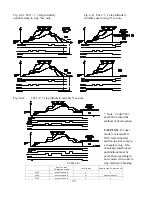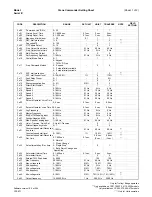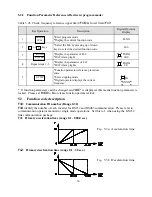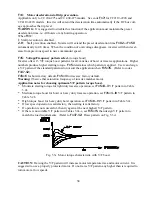
38
Fn4:
Motor deceleration stall trip prevention.
Applicable only to CC 204-275 and CC 404-475 models. See code
Fn71
for CC2110-2220 and
CC4110-4220 models. Inverter will extend the deceleration time automatically if the DC bus volt-
age approaches the trip level.
WARNING:
It is suggested to disable this function if the application must maintain the preset
deceleration time. ie: All hoists or any hoisting operation.
When
Fn4
=
1:
Stall prevention is disabled.
2-8:
Stall prevention enabled. Inverter will extend the preset deceleration time
Fn02
or
Fn50
automatically to 2-8 times. When the condition of overvoltage disappears, inverter will then decel-
erate from previous speed to new commanded speed.
Fn5:
Voltage/Frequency pattern select.
(torque boost)
Inverter offers 15 V/F torque boost patterns for all varieties of hoist or traverse applications. Higher
numbers produce higher starting torque.
Fn5
determines which pattern is applied. User can design
a V/F pattern if the standard patterns do not suit the application when
Fn5=15
. (Refer to codes
Fn37-42
).
Fn5=6
for hoist factory default,
Fn5=3
for traverse factory default.
Warning:
Observe that saturation frequency of inverter matches motor.
Application notes for choosing optimum V/F pattern torque boost.
* Moderate starting torque for light duty traverse operation, set
Fn5=0~3
V/F pattern in Table
5.2a
* Medium torque boost for hoist or heavy duty traverse operation, set
Fn5=4~10
V/F pattern in
Table 5.2b.
* High torque boost for heavy duty hoist operation, set
Fn5=11~14
V/F pattern in Table 5.2c.
* If low speed operation is satisfactory, then setting is satisfactory.
* If operation is not successful, then try again at the next highest V/F pattern.
* If there is no suitable V/F pattern in Tables 5.2a-c, set
Fn5=15
, then design V/F pattern to
match the load requirements. (Refer to
Fn37-42
) Draw pattern on Fig. 5.3d.
CAUTION:
Raising the V/F pattern will increase motor temperature rise and motor current. It is
suggested to use a properly protected motor. Do not raise V/F pattern any higher than is required to
turn motor at low speeds.
Fig. 5.3c Motor torque characteristic with V/F boost.
















































